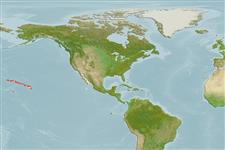Environment: milieu / climate zone / depth range / distribution range
Écologie
marin récifal; profondeur 6 - 730 m (Ref. 58302). Tropical; 30°N - 15°N
Eastern Pacific: throughout the Hawaiian Islands, including the Leeward Group; rare in Johnston Island.
Taille / Poids / Âge
Maturity: Lm ? range ? - ? cm
Max length : 18.0 cm TL mâle / non sexé; (Ref. 9710)
Épines dorsales (Total): 1; Rayons mous dorsaux (Total): 36-39; Épines anales 0; Rayons mous anaux: 32 - 36. Head and breast bluish gray, body yellowish or white. Head with irregular, oblique dark lines merging with many closely packed spots on body; region of mouth plus the lips white. Caudal fin red to orange, with a black sub terminal band; soft dorsal and anal fins clear to yellowish. Pelvic rudiment large narrowly attached to blackish posterior margin of ventral flap. Scale spinulation on midbody somewhat longer, finer and more acute than other species; each scale with high transverse ridge; male scale ridge rugosities develop at about 75 mm SL.
Inhabits coral reef areas (Ref. 9710). Benthopelagic over rock, rubble and sand; juveniles epi- and benthopelagic (Ref. 58302). Feeds on algae, small benthic invertebrates, and corals (Ref. 9710).
Life cycle and mating behavior
Maturité | Reproduction | Frai | Œufs | Fécondité | Larves
Hutchins, J.B., 1986. Review of the monacanthid fish genus Pervagor, with descriptions of two new species. Indo-Pac. Fish. (12):35 p. (Ref. 527)
Statut dans la liste rouge de l'IUCN (Ref. 130435)
Menace pour l'homme
Harmless
Utilisations par l'homme
Aquarium: Commercial
Plus d'informations
Noms communsSynonymesMétabolismePrédateursÉcotoxicologieReproductionMaturitéFraiRassemblement de ponteFéconditéŒufsDéveloppement de l'œuf
Taille/ÂgeCroissanceLongueur-poidsLongueur-longueurFréquences de longueursMorphométrieMorphologieLarvesDynamique des populations larvairesRecrutementAbondanceBRUVS
RéférencesAquacultureProfil d'aquacultureSouchesGénétiqueElectrophoresesHéritabilitéPathologiesTraitementNutrientsMass conversion
Outils
Articles particuliers
Télécharger en XML
Sources Internet
Estimates based on models
Preferred temperature (Ref.
123201): 5.5 - 15.2, mean 8.7 °C (based on 7 cells).
Phylogenetic diversity index (Ref.
82804): PD
50 = 0.5039 [Uniqueness, from 0.5 = low to 2.0 = high].
Bayesian length-weight: a=0.01995 (0.00943 - 0.04220), b=2.93 (2.75 - 3.11), in cm total length, based on LWR estimates for this (Sub)family-body shape (Ref.
93245).
Niveau trophique (Ref.
69278): 2.8 ±0.0 se; based on diet studies.
Résilience (Ref.
120179): Haut, temps minimum de doublement de population inférieur à 15 mois (Preliminary K or Fecundity.).
Fishing Vulnerability (Ref.
59153): Low vulnerability (10 of 100).
Nutrients (Ref.
124155): Calcium = 52.8 [21.1, 135.2] mg/100g; Iron = 0.706 [0.330, 1.782] mg/100g; Protein = 17.8 [15.4, 20.0] %; Omega3 = 0.143 [0.064, 0.316] g/100g; Selenium = 55.7 [24.1, 133.2] μg/100g; VitaminA = 60.8 [14.4, 257.0] μg/100g; Zinc = 1.33 [0.82, 2.16] mg/100g (wet weight);
